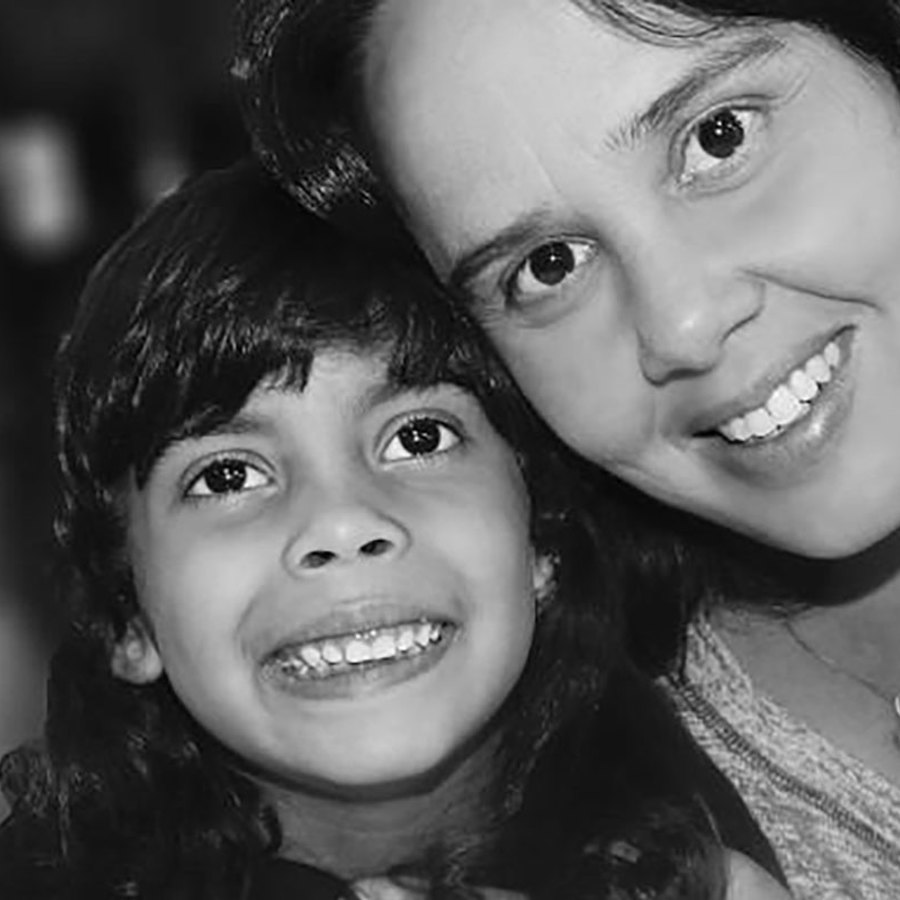
Do girls share more DNA with their paternal aunts than their maternal aunts?
October 11, 2012

- Related Topics:
- Recombination,
- Relatedness
A curious adult from Texas asks:
“I read your article on paternal grandmothers sharing more DNA with their granddaughters who are the children of their sons. It made me wonder if granddaughters are likely to share more DNA with their paternal aunts than with maternal aunts.”
The quick answer is that granddaughters share slightly more DNA on average with their maternal aunts, not their paternal ones. This is despite the fact that they share slightly more DNA on average with their paternal grandma compared to their maternal grandma.
Notice the words “slightly” and “on average”. Because of some randomness and chance in how DNA is inherited, this won’t always be true.
With paternal this and maternal that, I can quickly get lost. That is why I always draw things out like this:
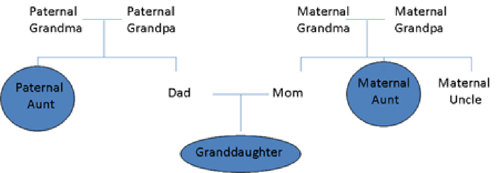

We are focusing on the people in the blue circles (paternal aunt, maternal aunt, and granddaughter). As you’ll see, on average the granddaughter shares a bit more DNA with her mom’s sister than she does with her dad’s sister.
To explain this, we need to take a quick step back and show why the granddaughter is, on average, more closely related to her paternal grandma. Then we will be able to take the next step and see why she is more closely related to her maternal aunt. As you’ll see it all has to do with the X and Y chromosomes, and DNA swapping.
X Marks the Spot
Most people have 23 pairs of chromosomes. One set of 23 comes from mom and the other from dad.
For our discussion here, we are going to ignore 22 of the pairs until the end. Instead we will focus all of our attention on the X and the Y chromosome (the 23rd pair).
The X and the Y are called the sex chromosomes. The genes on them determine whether a child will be a boy or a girl. Most people with two X chromosomes are girls, while most people with an X and a Y are boys.
This matters here because of something called recombination. In recombination, DNA is swapped between chromosomes in the same pair. So before you make an egg or a sperm, your two chromosome 1’s swap DNA. Same thing with your chromosome 2’s all the way through chromosome 22.
If you are a girl, your two X’s swap DNA too. But if you are a boy, your X and your Y pretty much pass to the next generation intact. They can’t swap DNA because they are too different from one another. This is ultimately why granddaughters are more related to their paternal grandma than their maternal grandma.
Maternal and Paternal Grandparents
Here is what I mean by paternal and maternal grandma (each is circled in blue):


To understand why the granddaughter is on average more related to dad’s mom than to mom’s mom, we need to look at everyone’s X and Y chromosomes and how they are passed down. I am going to be drawing a lot of pictures so before getting into this, I want to go over a couple of things.
First off, I will draw the X as a long rectangle and the Y as a sad little square. This reflects the actual size of each. Here is what the X and Y might look like in grandma and grandpa:


I have color coded them so we can keep track. So grandma has a dark pink and a light pink X and grandpa has a dark blue X and a light blue Y. (Remember, there are 22 other pairs we are ignoring.)
Here is what happens when these two have a son:


The first thing to notice is the effects of recombination on the X from grandma. Her two X’s mixed and matched their DNA before being passed on. So dad has a light pink X with darker pink ends.
I should note that the particular amount of mixing I’ve shown is one of a near infinite variety of possible combinations. This will be important later.
The last thing to notice is that there was no mixing of DNA between grandpa’s X and his Y. These two chromosomes are too different to swap much DNA and so they pass pretty much unchanged from father to child. (This is not true of a man’s other 22 pairs.)
So dad in this case gets his dad’s light blue Y intact and a mix of his mom’s two X’s. OK, now let’s add in mom’s family. Here is what this might look like:
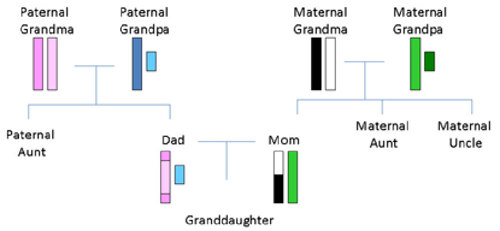

Again to keep track of which chromosome goes where, I have labeled each one a different color. So in addition to the pinks and blues of the paternal grandparents, I have included a black X and a white X for the maternal grandma and a light green X and a dark green Y for the maternal grandpa.
Notice that maternal grandma’s X’s swap DNA before being passed down too. This is why mom has an X with white on the top and black on the bottom.
There is still no mixing of DNA between grandpa’s X and his Y. What this means for mom is she pretty much gets her dad’s X intact. She has a whole green chromosome from her dad, the maternal grandpa.
Now let’s add the granddaughter to the equation:
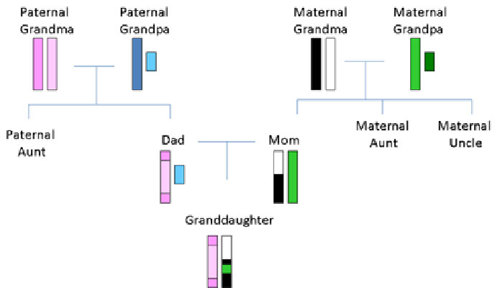

First off notice how dad’s X passed unchanged to his daughter (the granddaughter in this case). It still is mostly light pink with dark pink ends. Remember, this is because the X and the Y don’t swap much DNA between generations.
This is not true of the X that mom passed to the granddaughter. The granddaughter got a mix of both of mom’s X chromosomes. So now the granddaughter’s X has some black, white and green.
The end result is that the granddaughter shares 100% of her X chromosome with her paternal grandma but shares less than 100% with her maternal grandma. This is why on average granddaughters share more DNA with their dad’s mom than with their mom’s mom.
It is important to emphasize this happens on average. Remember, the other 22 chromosome pairs are all going through the same process as the X in mom. This free wheeling DNA swap is pretty random meaning you can by chance end up with more DNA from one grandparent than the other. (I’ll deal with this more at the end.)
Now let’s have a peek at maternal aunts and uncles. As you’ll see, the special unchanged nature of the X on dad’s side of the family is lost with his sisters but maternal grandpa’s X is gained. That is why the granddaughter is more related (on average) to her maternal aunt compared to her paternal aunt.
Aunties and Uncles
Let’s add the paternal and maternal aunts to the story. Here is one way things might turn out:
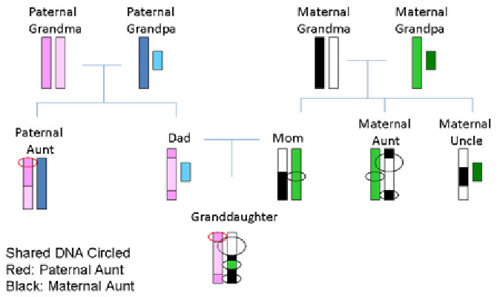

The first thing to notice is that the brothers and sisters do not get the same X from their mother. They get a mix of her two X’s but how much of each is random.
So dad’s X chromosome is light pink with dark pink at the ends but his sister has an X with dark pink at the top and light pink at the bottom. They share just the little bit at the top (circled in red on the paternal aunt). This also means that the paternal aunt only shares that much of her X with the granddaughter.
The same sort of thing happens on mom’s side of the family. By chance mom shared a lot of her mother’s X with her sister. Here it happens to be more than dad shared with his sister. Not only that, the two of them share some of the X chromosome from their dad, the maternal grandpa.
Mom passed on a mix of this to the granddaughter. And if you look at the circles on the granddaughter’s X chromosomes, you can see she has more in common with her maternal aunt than her paternal one. (At least for this chromosome pair!)
As you can see, the maternal grandfather’s X is an important difference. Because it passes unchanged to all of his daughters, the granddaughter shares more DNA on average with her maternal aunt compared to her paternal aunt. She has more shared green.
Adding back in the other 22 chromosome pairs
This stuff is so complicated! But remember, things are actually even a bit more complicated.
We have been focusing on a single chromosome pair (the X and the Y). When we add the other chromosomes, this lone pair quickly loses its significance.
Just to finish things off, here is what things might look like with all the chromosomes. To simplify things, I have left out the aunts and am just focusing on the granddaughter and the grandparents:


The color scheme is different here as I just want to emphasize DNA from each parent. (And I am also ignoring DNA swapping from grandparents to parents.) Let’s focus on the light blue and the pink in the granddaughter. If we just look at the X (which I have drawn as an X), then she is more related to her paternal grandma. In this case she got twice as much X from her paternal grandma compared to her maternal grandma.
But as you can see, the X isn’t everything. In fact, it is only a small part of all of the granddaughter’s DNA.
When we look at all of the DNA, we see that in this case there is more light blue than pink. She is more related to her maternal grandma!
This is just one of a nearly infinite variety of possible DNA combinations from the four grandparents. A slight majority of granddaughters will share more DNA with their paternal grandma because of the X chromosome, but a sizable minority won’t. They will have more in common with their maternal grandma.
The same goes for paternal and maternal aunts too. A slight majority will share more DNA with their maternal aunt because of the X chromosome, but a sizable minority won’t. They will have more in common with their paternal aunt.
So remember to focus on the whole picture. There is a whole lot going on in a cell and the X and the Y are only a small part of it.

Author: Dr. D. Barry Starr
Barry served as The Tech Geneticist from 2002-2018. He founded Ask-a-Geneticist, answered thousands of questions submitted by people from all around the world, and oversaw and edited all articles published during his tenure. AAG is part of the Stanford at The Tech program, which brings Stanford scientists to The Tech to answer questions for this site, as well as to run science activities with visitors at The Tech Interactive in downtown San Jose.
 Skip Navigation
Skip Navigation
